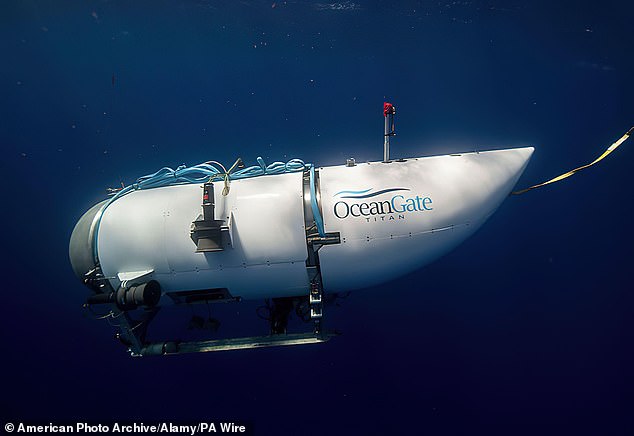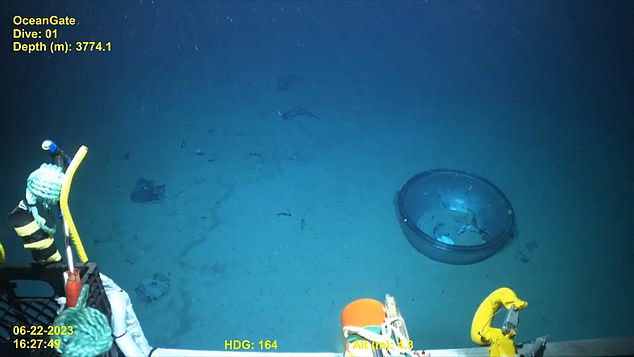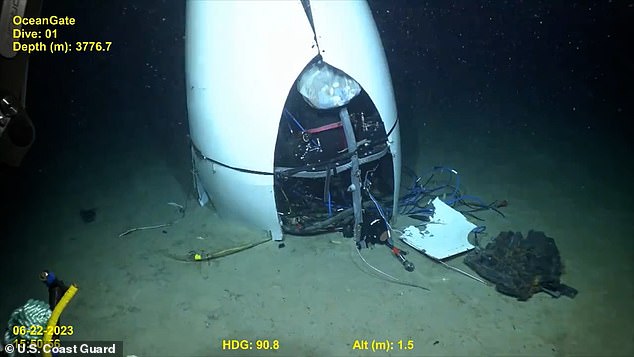Scientists investigating Titan submersible reveal explosive new details about fault that killed crew
Scientists investigating the doomed submarine Titan have discovered shocking new details about the possible cause of its catastrophic implosion.
Former chief scientific officer Dr. Steven Ross testified before a U.S. Coast Guard panel on Thursday, admitting that the OceanGate submarine experienced a “platform problem” just days before the fatal mission to the Titanic in June 2023.
The malfunction caused passengers on board to “troll” and a crew member to crash into a bulkhead, which a physicist said was the spot where water first entered Titan.
The expert, who was not involved in the hearing, suggested a defective connection at the front between the carbon fiber of the hull and the titanium ring, the location of the bulkhead, caused the explosion.
An astrophysicist analyzed recently released images of the Titan wreckage from OceanGate on the seafloor and suspects the submarine did not implode from the center out, as many have suggested
The Titan submarine disappeared on June 18, 2023, but the team involved in its development is now on trial for the deadly event.
Dr Ross told the panel that when the failure occurred, ‘one passenger was hanging upside down. The other two managed to squeeze themselves into the bow cowl.’
The former science director said he did not know whether an official assessment of Titan’s hull had been conducted before the ship crashed into the Atlantic Ocean, but he assured him that the staff was competent.
But a few days later, Titan was lowered into the Atlantic Ocean and the failure has remained secret to this day.
Earlier this week, the US Coast Guard released eerie deep-sea footage showing the wreck lying on the seabed.
And physicist Scott Manley set out to see if there were any clues to what was happening 3,800 meters below the Earth’s surface.
It has long been hypothesized that the carbon fiber and titanium of the hull collapsed under the extreme pressure.
If the failure had occurred in the middle, Manley explained that water would have flowed in both directions, leaving carbon fiber debris in the front and back of the submarine.
Images of the wreckage showed only carbon debris in the center of the fuselage. The nose cone was found without surrounding debris, and the tail was blown off to the side.
“Based on what I know and what I see here, the pressure hull ruptured at the adhesive bond between the carbon fiber and the titanium ring at the front of the submarine. That rupture propagated aft, with the water pushing everything to the back of the cabin in milliseconds,” Manley said. shared on X.
“The front just fell off, the bolts holding it on probably snapped off by the water coming in, and the window just popped out. No idea where that is.”
Manley further explained his theory in a YouTube videoindicating that the failure began at the forward bulkhead that divided the submarine’s interior into watertight compartments.
And on the Titan, this area is a large, silver ring of titanium.

The Titan submarine disappeared on June 18, 2023. There were five people in the vehicle when it imploded.
The astrophysicist, who also works as a programmer for Apple, said water began flowing into that area and a crack opened that extended toward the back of the submarine.
This also pushed the hull backwards and the sides were pressed inwards.
What’s happening now is that water is flowing through [the front gap] and the forward nose, which caused the window to pop out,” Manley said, noting that that was the reason the window was missing from the nose cone on the seafloor.
He further explained that the incoming water was tearing the submarine apart from the inside.
Then, water slammed into the rear bulkhead, separating the cone-shaped tail from the rest of Titan.
So what you’re left with is [rear ring] and a lot of carbon fiber debris,” Manley continued.

Scott Manley, who has a Master of Science in computational physics, noted that the front of the nose was found without surrounding debris, indicating the problem was occurring on the front of Titan

He claimed that there was a faulty connection between the hull and the large titanium ring, which allowed water to seep in from the front and push the submarine apart. The photo shows the tail of the Titan on the seabed
And that’s exactly what’s shown in the recently released footage.
The titanium rings were attached with a glue similar to epoxy glue that is applied by hand.
However, this is exactly the same process that the US Navy uses when building its submarines.
“You have to make sure that the titanium portion and the carbon fiber portion move the same way when pressure is applied to them,” Manley said.
‘Otherwise you will get transferred and you will experience extra stress.
‘If this deviates by a few percent, it can lead to additional tension at these interfaces.
‘But it could also be that the glue was bad and it fell apart.’
